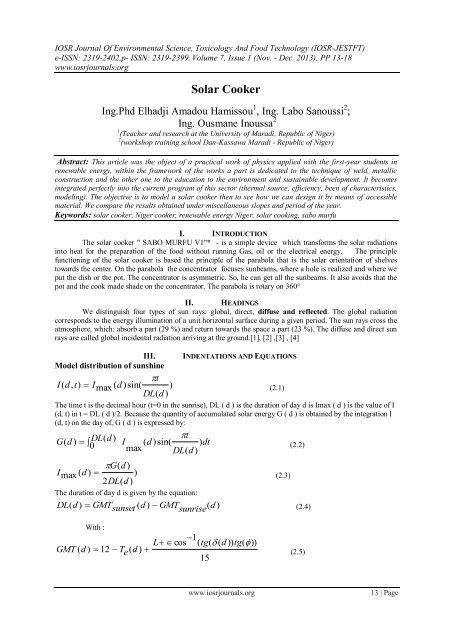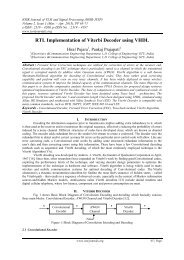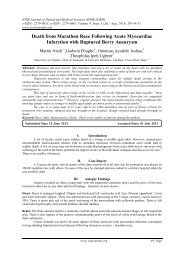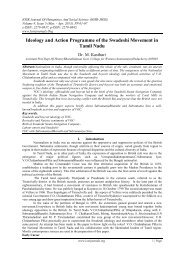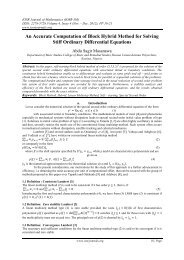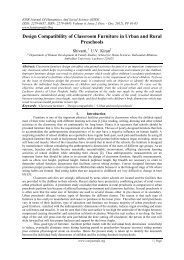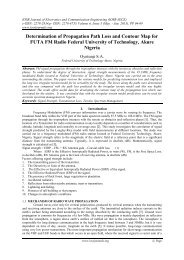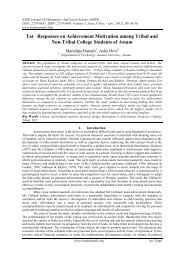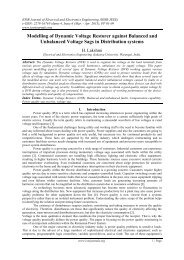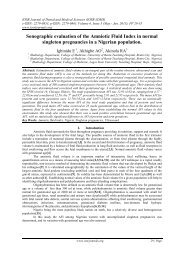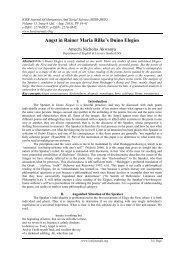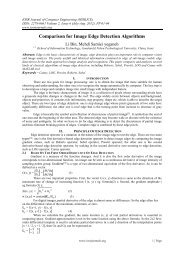You also want an ePaper? Increase the reach of your titles
YUMPU automatically turns print PDFs into web optimized ePapers that Google loves.
<strong>IOSR</strong> Journal Of Environmental Science, Toxicology And Food Technology (<strong>IOSR</strong>-JESTFT)<br />
e-ISSN: 2319-2402,p- ISSN: 2319-2399. Volume 7, Issue 1 (Nov. - Dec. 2013), PP 13-18<br />
www.iosrjournals.org<br />
<strong>Solar</strong> <strong>Cooker</strong><br />
Ing.Phd Elhadji Amadou Hamissou 1 , Ing. Labo Sanoussi 2 ;<br />
Ing. Ousmane Inoussa 2<br />
1 (Teacher and research at the University of Maradi, Republic of Niger)<br />
2 (workshop training school Dan-Kassawa Maradi - Republic of Niger)<br />
Abstract: This article was the object of a practical work of physics applied with the first-year students in<br />
renewable energy, within the framework of the works a part is dedicated to the technique of weld, metallic<br />
construction and the other one to the education to the environment and sustainable development. It becomes<br />
integrated perfectly into the current program of this sector (thermal source, efficiency, been of characteristics,<br />
modeling). The objective is to model a solar cooker then to see how we can design it by means of accessible<br />
material. We compare the results obtained under miscellaneous slopes and period of the year.<br />
Keywords: solar cooker, Niger cooker, renewable energy Niger, solar cooking, sabo murfu<br />
I. INTRODUCTION<br />
The solar cooker " SABO MURFU V1"* - is a simple device which transforms the solar radiations<br />
into heat for the preparation of the food without running Gas, oil or the electrical energy. The principle<br />
functioning of the solar cooker is based the principle of the parabola that is the solar orientation of shelves<br />
towards the center. On the parabola the concentrator focuses sunbeams, where a hole is realized and where we<br />
put the dish or the pot. The concentrator is asymmetric. So, he can get all the sunbeams. It also avoids that the<br />
pot and the cook made shade on the concentrator. The parabola is rotary on 360°<br />
II. HEADINGS<br />
We distinguish four types of sun rays: global, direct, diffuse and reflected. The global radiation<br />
corresponds to the energy illumination of a unit horizontal surface during a given period. The sun rays cross the<br />
atmosphere, which: absorb a part (29 %) and return towards the space a part (23 %). The diffuse and direct sun<br />
rays are called global incidental radiation arriving at the ground.[1], [2] ,[3] , [4]<br />
III. INDENTATIONS AND EQUATIONS<br />
Model distribution of sunshine<br />
max ( t<br />
I ( d,<br />
t)<br />
I d )sin( )<br />
(2.1)<br />
DL(<br />
d )<br />
The time t is the decimal hour (t=0 in the sunrise), DL ( d ) is the duration of day d is Imax ( d ) is the value of I<br />
(d, t) in t = DL ( d )/2. Because the quantity of accumulated solar energy G ( d ) is obtained by the integration I<br />
(d, t) on the day of, G ( d ) is expressed by:<br />
t<br />
G d<br />
DL(<br />
d )<br />
<br />
( ) 0<br />
I ( d )sin( ) dt<br />
(2.2)<br />
max DL(<br />
d )<br />
Imax ( d )<br />
G(<br />
d )<br />
)<br />
2DL(<br />
d )<br />
(2.3)<br />
The duration of day d is given by the equation:<br />
DL( d)<br />
GMT sunset ( d)<br />
GMT<br />
sunrise<br />
( d)<br />
(2.4)<br />
GMT ( d )<br />
With :<br />
12 T e ( d ) <br />
1<br />
L cos ( tg(<br />
( d )) tg(<br />
))<br />
(2.5)<br />
15<br />
www.iosrjournals.org<br />
13 | Page
<strong>Solar</strong> <strong>Cooker</strong><br />
sin(2( N(<br />
d ) 10))<br />
e(<br />
d)<br />
0.123cos( N(<br />
d)<br />
87) <br />
6<br />
T (2.6)<br />
( d)<br />
23.45cos( N(<br />
d)<br />
10)<br />
(2.7)<br />
<br />
N ( d)<br />
0.988 D(<br />
d)<br />
30.3( m 1)<br />
(2.8)<br />
<br />
GMT ( d ) represent the hours of rise and day sunset d; with = 1 for the sunset and = 1 for the rise. L the<br />
longitude is, ϕ is the latitude, Te(d) is the equation of time (in the hour), δ(d) is the declension (in degree). D (d)<br />
represent the day number in the month, m the number of the month ( January =1 ), and N ( d ) the day number<br />
in the year. (Fig.1.0)<br />
Model distribution of temperature<br />
This model uses the minimal ambient temperature Tmin ( d ) and maximal Tmax ( d ) (measured or<br />
estimated) for one day d to express the distribution, under sinusoidal shape, the ambient temperature T (d, t)<br />
during all day d:<br />
Tmax ( d ) T<br />
min<br />
( d ) Tmax ( d ) T<br />
min<br />
( d ) ( t 1)<br />
T ( d,<br />
t)<br />
<br />
<br />
sin( )<br />
2<br />
2<br />
12<br />
The time t is counted since the sunrise for the day d.<br />
All the sunbeams are focused in the center of the parabola.<br />
F - The focal length between the origin O and thefoyer F<br />
The summit of the parabola is O (Pic.1.1)<br />
Let M (Xo, Yo) a point situated on the parabola the tangeante M has for equation = ½ XOX / F - Yo. The<br />
normal M has for equation Y=-2xf / xo + 2f+yo<br />
U is in the middle of Oxo<br />
U is in the middle of TM<br />
O is in the middle of Tyo<br />
The parabola is a curve the equation of which is y = X 2 /4f (Fig.1.2)<br />
Equation of distribution of the heat in a homogeneous bar:<br />
2<br />
u<br />
k<br />
u<br />
<br />
t<br />
2<br />
cx<br />
With<br />
2<br />
a <br />
k<br />
c<br />
2<br />
u<br />
2 u<br />
a<br />
t<br />
2<br />
x<br />
(a is the coefficient of diffusivité thermal expressed in en m 2 .s –1 ).<br />
ρ : factor of reflection<br />
α : Factor of absorption or absorptivity<br />
τ : Factor of transmission or transmissivité<br />
we have naturally: ρ + α + τ: = 1<br />
Furthermore, any body which warms up emits in its environment a radiation of conversely proportional<br />
wavelength in its temperature. The law of Wien gives the wavelength of the maximum of emission, issue<br />
according to the body temperature<br />
After all, a thermal solar cell has to accept the maximum of sun rays (high transmittance), absorb the major part<br />
(high absorbance ), emit it and let take out the least possible (transmittance reduced in the long waves). [5], [6]<br />
Heat balance of a sensor<br />
The useful power is the one who allows to warm the debit of coolant m of the temperature of entrance<br />
Tentry until the temperature of exit Texit:<br />
Eu mcp ( T<br />
exit<br />
Tenttry )<br />
- E: the incidental solar power from the point of view of the sensor (W/m 2 )<br />
(2.9)<br />
www.iosrjournals.org<br />
14 | Page
<strong>Solar</strong> <strong>Cooker</strong><br />
- Tm: the temperature averages of the sensor (approximation in the average between the temperatures of<br />
entrance and sensor's exit (°C).<br />
- Text: the outside temperature (°C)<br />
and parameters defining the sensor: :<br />
β: the optical factor of the sensor, which is the relationship enters the period of sunshine absorbed by the<br />
absorber and the incidental period of sunshine on the glazing. This optical factor is the product of the factor of<br />
transmission of the glazing τ by the coefficient of absorption of the absorber α.<br />
K: The coefficient of thermal decreases (W / ° C)<br />
The heat balance in still regime of the sensor expresses that the absorbed power ταE divides up between the<br />
useful Had power Eu and the heat losses:<br />
. .<br />
E K(<br />
Tm Tout)<br />
mcp ( Texit Tentry)<br />
Eu Had is thus equal to the part of the incidental power crossing the glazing and absorbed by the absorber,<br />
decreased in the thermal decreases (proportional away from temperature between the sensor and the<br />
atmosphere):<br />
Eu . E.<br />
K(<br />
Tm Tout)<br />
[7] , [8]<br />
IV.<br />
FIGURES<br />
Fig.1.0 the declension δ of sun (in degree).<br />
Fig.1.1 Construction of the parabola.<br />
Fig.1.2 Determination of the center of the parabola.<br />
www.iosrjournals.org<br />
15 | Page
<strong>Solar</strong> <strong>Cooker</strong><br />
Fig.:1.4 Insolation(sunstroke) in Republic of Niger (december)<br />
Fig.: 1.5 World Map for solar radiation<br />
www.iosrjournals.org<br />
16 | Page
<strong>Solar</strong> <strong>Cooker</strong><br />
Fig. 1.6 Students in pratical metallic construction (<strong>Solar</strong> cooker)<br />
V. CONCLUSION<br />
This study allowed us to see in the context of the republic of Niger the efficiency of a solar cooker.<br />
The study showed us that the proper functioning of solar cooker near that 10 months in the year.<br />
The solar cooker participates in the local economy, struggle against poverty and protects the environment.<br />
www.iosrjournals.org<br />
17 | Page
<strong>Solar</strong> <strong>Cooker</strong><br />
Acknowledgements<br />
All my thanks to the foremen of the Technical Secondary school DAN-KASSAWA of Maradi and<br />
don’t forget the serious of the students Renewable Energy University of Maradi Republic of Niger.<br />
REFERENCES<br />
Books:<br />
[1] Methods of calculation of the renewable energies; VISSARIONOV Vladimir Ivanovitch and Deriojina J. V., H.K. Malinin,<br />
Burmisov A.A ., Kusnesov V.A.<br />
[2] Duffie, Has. And John Beckman, William A. 2006: engineering of solar thermal processes, Wiley.<br />
[3] Henning, HM on 2003: assisted solar air conditioning of buildings - A manual worker for the planners.<br />
[4] Peuser, Has. Felix, Remmers, Karl-Heinz and Schnauss, Martin, on 2002: thermal solar systems, a good planning and of<br />
construction,<br />
[5] THERMAL SOLAR ENGINEERING OF PROCESSED: Jon Duffie, WilliamA Beckman; John Wiley and Sounds: New-York<br />
[6] FUNDAMENTAL OF HEAT TRANSFER: Frank Incropera, David p. Dewitt; John Wiley and Sounds, New- York<br />
[7] Electric Conversion of the renewable energies ( CEER); MAHER Chaabene, Lecturer in the ISEC of SFAX<br />
Journal Papers:<br />
[8] International Organization for Standardization, on 1994: test methods of solar cells, HAVE it, Geneva * SABO MURFU V1 : New<br />
<strong>Cooker</strong> version 1, In Hausa the principal language of Republic of Niger<br />
www.iosrjournals.org<br />
18 | Page


